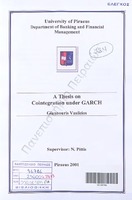| dc.description.abstractEN | The motivation and central idea of this thesis, in a statistical point of view, rises from the properties and long-run relationship of pairs of financial time series. These can be forward and spot exchange rates, short-run and long-run interest rates. This category of series contains a lot of crucial information for econometric forecasting. Concerning the relationship of the regression vectors, we are not about to check for causality in any form. Modeling the type of long-run interaction in the framework of cointegration, in effect, we establish a long-run equilibrium-type equation between the integrated series. This type of relation is versatile and mathematically well defined. In the economic theory of behavior under uncertainty, an agent must make a decision based upon the distribution of a random variable sometime in the future. Assuming a general utility function and risk averse agents, not only the conditional distribution affects the decision but a measure of the dispersion is also of primary importance. As long as we maintain the convenient assumption of linear covariance stationary models, we imply that most measures of uncertainty will remain constant over time. So in the GARCH territory we emerge ourselves because of the properties of the involved series. Even though exchange rate changes are serially uncorrelated, they are not independent. Where many used to perceive the data as pure noise, now they usually can see that “large changes tend to be followed by large changes, of either sign, and small changes tend to be followed by small changes” (Mandelbrot 1963). This type of feature is very common in interest rate and exchange rate changes. From an empirical standpoint, it is important to model any temporal variation in the volatility process. The Autoregressive Conditional Heteroskedastic model introduced by Engle (1982) explicitly recognizes this type of temporal dependence. The key insight offered by the ARCH model lies in the distinction between the conditional and the unconditional second order moments. While the unconditional covariance matrix for the variables of interest may be time invariant, the conditional variances and covariances often depend non-trivially on the past states of the world. Understanding the exact nature of this temporal dependence is crucially important for many issues in macroeconomics and finance, such as irreversible investments, option pricing, the term structure of interest rates, and general dynamic asset pricing relationships. Also, from the perspective of econometric inference, the loss in asymptotic efficiency from neglected heteroscedasticity may be arbitrarily large and, when evaluating economic forecasts, a much more accurate estimate of the forecast error uncertainty is generally available by conditioning on the current information set. Thus, there is a tendency for extreme values to be followed by other extreme values, but of unpredictable sign. With these characteristics in mind we are about to test the performance of various commonly used estimators in the environment of Cointegration under GARCH. Our first step is to examine the theoretical asymptotical properties of each estimator assuming we had infinite samples. Realizing that the information set is never enough in financial forecasting we will test again the performance in finite samples using Monte Carlo simulations. | el |



